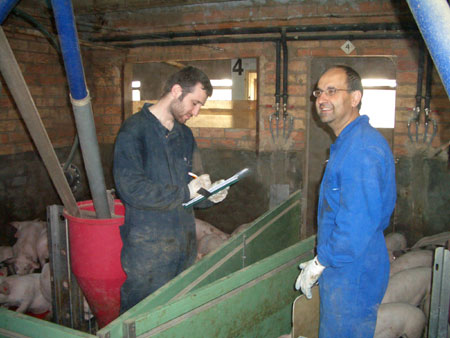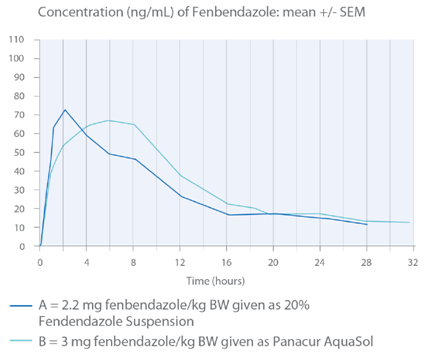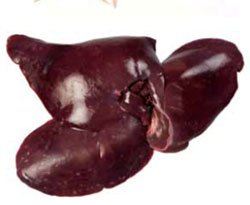



‘Wet Milling’ Technology Advances Science of Worm Control in Pigs
A new process from MSD Animal Health improves suspension, stability and bioavailability of field-proven compound.
A manufacturing technology used for decades by the pigment industry is now helping European pig producers obtain better control of three important internal parasites that impair production and animal health.
The search for a better pig dewormer began about five years ago, when scientists at MSD Animal Health saw the European pig industry seeking alternatives to standard feed medications.
“It became clear that pig farmers were looking for different ways to deliver medications. As that demand intensified, the need for an alternative became apparent,” explained Miquel Collell, DVM, director, Scientific Marketing Affairs at MSD Animal Health.
Administering dewormers through the drinking water is one available alternative, but many products have their drawbacks.
“Their physical stability and homogeneity are less than ideal and they tend to leave sediment that clogs bulk tanks, pipes, filters and nipples, which makes them inconvenient to use and raises concerns that pigs could be under-dosed,” he said.
MSD Animal Health decided to tackle the problem and charged its scientists at the MSD Animal Health Innovation facility in Schwabenheim, Germany, with the task of developing a better water dewormer.
After exploring numerous options, the scientists found that the process of wet milling — widely used for decades to manufacture pigments — showed promise, Dr Collell said.
The research team applied the wet-milling technology to the company’s popular dewormer Panacur® (fenbendazole 200mg per mL), and developed a proprietary, state-of-the-art process that successfully resulted in a new water formulation of the product. The result was Panacur AquaSol (fenbendazole 200mg per mL), a highly stable suspension that is simply mixed into the pigs’ drinking water.
“It’s very easy to administer, has excellent efficacy and is designed for use in bulk tanks or the proportioner systems found on many swine farms,” Dr Collell said.

Sub-micron Particles Make It Possible
According to Mario Sommer, PhD, a research scientist with MSD Animal Health Innovation, the patented wet-milling process utilises zirconium beads, which reduce the product’s active ingredient to a refined, homogenous and sub-micron particle size.
“The particles are so narrow and fine that they mix very easily in drinking water,” explained Dr Sommer. “In the final medicated water concentrations, they stay suspended for 24 hours so they won’t clog equipment. Once you prepare and stir it the first time, you don’t need to stir again for 24 hours.”
Perhaps the most important advantage of the technology, however, is improved bioavailability. “The average relative bioavailability of fenbendazole from Panacur AquaSol has increased by over 30 per cent compared to an in-feed formulation,” Dr Sommer explained (Figure 1).

Because the small particles dissolve faster, there is more active drug in the intestinal tract. That makes more of the active ingredient available for absorption in a shorter period of time, he said.
Panacur AquaSol, which can be used in weaners, growers, gestating sows and boars, requires only two days of treatment for all stages of Ascaris suum (large roundworms) and the adult stages of Oesophagostomum spp (nodular worms). For the pre-adult and adult stages of Trichuris suis, three days of treatment is effective.
The stability, more even particle size and improved distribution of fenbendazole help ensure that each pig gets the recommended dose of dewormer, Dr Sommer said.
Worm Prevalence

[Photo: Anja Gruenewald for MSD Animal Health]
Dr Collell said many swine producers do not fully appreciate the extent of internal worm infections because there may not be obvious clinical signs.
He points to a presentation delivered by Jozef Vercruysse, DVM, professor and veterinary parasitologist at Ghent University, Belgium, who pointed out that the high prevalence of liver white spots observed in many countries in Europe “is strongly indicative that A. suum is present on many farms”. (Figure 2.)
These white spots, however, can heal by slaughter time. Producers may not realise that A. suum was present but the infection takes a toll by eating away at profits, Dr Collell continued. Published studies indicate that the cost of A. suum infection alone can run as high as €9 to €10 per pig due to production losses that include lower feed conversion, delayed time to market and liver and lung damage1.
Studies also indicate that worm infection can reduce the efficacy of vaccines for other important diseases, such as mycoplasma, he says2.
Efficacy Studies
Field trials conducted in Europe demonstrated that after treatment with Panacur AquaSol, the reduction in faecal egg counts for A. suum and Oesophagostomum spp. dropped by nearly 100 per cent. In T. suis efficacy studies, adult worm counts dropped over 93 per cent and the faecal egg count dropped from 505 eggs per gram before treatment to nearly zero eggs per gram after treatment3.
“It’s significant that Panacur AquaSol is effective against all stages of A. suum because 90 per cent of worm larvae are already in the liver and lungs just three days after infection,” Dr Collell noted. “Medications that only kill adult worms allow the larvae to complete their cycle within three weeks.”
He added that the dewormer also has an ovicidal (egg) effect and if you reduce or eliminate worm egg shedding, you help prevent continuous contamination of your farm.
“That helps keep pigs healthy, enables them to grow faster and reduces losses you incur if your herds are infected with worms,” he said.
By deworming pigs through drinking water, producers can more easily time treatments to manage healthy herds effectively.
“That’s more difficult to do with in-feed treatments because the feed might not be blended and delivered to the farm at the optimum treatment time,” Dr Collell said.
Asked about the palatability of the new wormer, the veterinarian says that MSD Animal Health scientists used a water meter in one of the studies to monitor water consumption.
“Pigs receiving Panacur AquaSol drank just as much as unmedicated pigs,” he reported.
Deworming Schedule
For optimal internal worm control, Dr Collell advises using Panacur AquaSol for outdoor gilts and sows upon their arrival while in quarantine and then again five to seven days before each farrowing. Sows should be treated at the end of gestation or a few days before entering the farrowing unit to clear adult worms and A. suum larvae, which will prevent infection of their piglets.
Piglets should be treated three times: at eight to 10 days post-weaning; approximately six weeks later when entering the fattening unit; and again in another six weeks.
Boars should be treated three times a year, he recommended, and added that the product has a four-day withdrawal time for meat and offal.
Dr Collell emphasised that for good worm control, swine producers also need to manage the environment.
“Consider that for every parasite living inside one pig, there are an estimated 100 to 1,000 more living outside,” he said. “A. suum eggs can survive outside the host for up to nine years.”
This is why it is important to use a dewormer that has an ovicidal effect and why decreased shedding is so important.
“In addition to deworming animals regularly to preserve their health and prevent continuous recontamination of their surroundings, pens should be cleaned regularly and thoroughly with hot, high-pressure water or steam, then allowed to dry. Manure should be composted so the temperature reaches 55°C (131°F). Birds, rodents and insects should be prevented from entering pig houses since they can be carriers for worms,” he continued.
All of these procedures can help farmers manage a healthy herd.
“Strategic deworming along with environmental management can go a long way toward improving herd health and improving producer profits,” Dr Collell said.
References
- Data on file, MSD Animal Health.
- Porc Magazine. July/August 2004, No. 379;56-60.
- Data on file. MSD Animal Health.
November 2013









